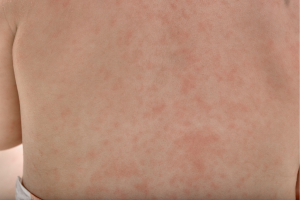Roseola is a viral infection primarily affecting children between 6 months and 2 years old. The condition is typically characterized by a high fever lasting for several days, followed by a distinctive rash as the fever subsides. Dr. Bornstein discusses the symptoms, causes, and treatment for Roseola.

DEFINITION:
A viral illness with a characteristic rash called exanthem subitum.
SYMPTOMS:
Cold symptoms followed by a fever of up to 106 degrees. The fever persists for about five days, breaks, and then a rash develops. The rash starts from the trunk and spreads outward. It lasts about three days and then fades away.
CAUSES:
Viruses are called human herpes virus six and human herpes virus seve.
DIAGNOSIS:
The diagnosis of the illness is primarily based on clinical symptoms, with a blood test being rarely necessary.
CONTAGION:
The virus that causes roseola is contagious until the rash has disappeared. The incubation period is 3-7 days.
TREATMENT:
Other than keeping the child comfortable with fluids, rest, and fever medicines, no treatment is necessary.
DISCUSSION:
Roseola infantum is called this because of the rosy rash. The peak age for this illness is 6-15 months of age, with 95% of cases happening in children less than three years of age. Children with roseola typically appear well despite having a high fever. Children will usually visit a physician since the fever is typically so high. The physician will most likely diagnose a viral illness. Subsequently, the rash will develop, confirming the diagnosis. Since the fever can run so high, a febrile seizure may occur. This happens in 5-10% of children with this illness. This seizure, although frightening, is harmless. Although this illness is typically harmless, complications with the liver and brain have been reported. These complications are extremely rare.
ONE DOCTOR’S OPINION:
It is always worrisome when a child gets a fever of 106 degrees. A more serious illness is unlikely if the child appears well with the fever. Once the fever breaks and the rash develops, everyone can sigh a sigh of relief. This is Roseola. It will just run its course and go away.
This blog was written by Dr. Michael Bornstein, who has 30 years of experience as a pediatrician.
Disclaimer: The contents of this article, including text and images, are for informational purposes only and do not constitute a medical service. Always seek the advice of a physician or other qualified health professional for medical advice, diagnosis, and treatment.


FOLLOW US